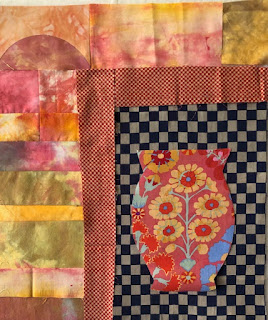Saturday, August 24, 2024
As above, so below
Monday, April 22, 2024
"Starburst"
Wednesday, March 27, 2024
There's a crack in everything...
 There is a practice in Japan known as ‘kintsugi’, when
broken vessels are reconstructed using gold to join the pieces. It comes from
the idea that by embracing flaws and imperfections it is possible to create an
even stronger and more beautiful vessel, and offers a reminder that good can come out of adversity when things fall apart. The small vessel in the right hand
corner has a lid that can be removed to let the light in. This fabric itself is
very likely a hundred years old, having been brought back from Damascus (then
part of the British mandate for the area known as Palestine) following the
defeat in WWII of the Ottoman rule in this area of the Middle East. A friend’s
father had been stationed there and he brought back these beautiful fabrics from Damascus for
his wife and daughters to be made into frocks. I treasure them
There is a practice in Japan known as ‘kintsugi’, when
broken vessels are reconstructed using gold to join the pieces. It comes from
the idea that by embracing flaws and imperfections it is possible to create an
even stronger and more beautiful vessel, and offers a reminder that good can come out of adversity when things fall apart. The small vessel in the right hand
corner has a lid that can be removed to let the light in. This fabric itself is
very likely a hundred years old, having been brought back from Damascus (then
part of the British mandate for the area known as Palestine) following the
defeat in WWII of the Ottoman rule in this area of the Middle East. A friend’s
father had been stationed there and he brought back these beautiful fabrics from Damascus for
his wife and daughters to be made into frocks. I treasure themFriday, March 15, 2024
Red poppies at sunset
For over a year now I’ve been concentrating my textile creative pursuits in one direction. That may sound limiting. Fabrics themselves of course offer limitations by the permanency of designs, colour and type of fabric itself. But they also seek to evoke a different perspective in the looking. But being only in the thematic content it is actually very liberating while being contained mainly to context. A paradox? Perhaps, in theory, but the practice has shown to be otherwise. There has been a rediscovery of older techniques and in the process, finding alternative ways of achieving the desired effect– including paint on fabric!
The main approach has been of course machine applique, placed on top of pieced blocks stored over time and awaiting resurrection as part of the background. With the theme being vases, usually containing flowers, I have used the floral fabrics collected over the past 30 years to provide me with a botanic array from the endless beauty that surrounds us in nature – though limited by my collection! (I mentioned in an earlier post that I was not buying any new fabrics, and I have broken that only once – so far!)
I had initially placed some conditions around the design for the background that possibly had come from the influence of the ‘still life’ genre. There would be a window revealing a moon or sun scape, a curtain or frame divide, and of course a tablecloth for the vase of flowers to rest on. In this there is continuity throughout the exploration of diversity. What I wanted to avoid was the overwhelming demand for the traditional notion of perspective – what we call the ‘vanishing point’ as discovered by Renaissance painters in their quest to accurately represent what they saw before them. David Hockney has shown with many examples how the use of a grid helped in achieving this appearance of three-dimensional perceptions that we are familiar with in landscape art…the way we are accustomed to seeing it.
It was a viewpoint that challenged those of the day. Art was bound by religious dogma and two-dimensionally flat, presenting themes not of this world but of the world to come in the afterlife from following the rules of the Church in life. The vases are my way to challenge that belief, and engender one that is relevant to our times: heaven is here on earth in all its beauty and grandeur if only we can see it. And then do all we can to protect it as our home.
 |
| Red poppies at sunset (20x16") |








